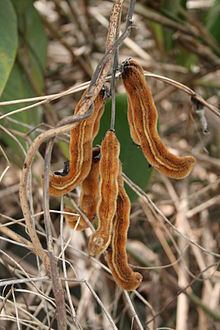Subfamily Faboideae Scientific name Mucuna Rank Genus | ||
 | ||
Lower classifications Velvet bean, Mucuna holtonii | ||
Mission mucuna and finding the plant
Mucuna is a genus of around 100 accepted species of climbing vines and shrubs of the family Fabaceae, found worldwide in the woodlands of tropical areas.
Contents
The leaves are tripalmate, alternate, or spiraled, and the flowers are pea-like but larger, with distinctive curved petals, and occurring in racemes. Like other legumes, Mucuna plants bear pods. They are generally bat-pollinated and produce seeds that are buoyant sea-beans. These have a characteristic three-layered appearance, appearing like the eyes of a large mammal in some species and like a hamburger in others (most notably M. sloanei) and giving rise to common names like deer-eye beans, donkey-eye beans, ox-eye beans, or hamburger seed.
The name of the genus is derived from mucunã, a Tupi–Guarani word for these species.
Mucuna pruriens
Uses and ecology
The pods of some species are covered in coarse hairs that contain the proteolytic enzyme mucunain and cause itchy blisters when they come in contact with skin; specific epithets such as pruriens (Latin: "itching") or urens (Latinized Ancient Greek: "stinging like a nettle") refer to this. Other parts of the plant have medicinal properties. The plants are used in herbalism against a range of conditions, such as urinary tract, neurological and menstruation disorders, constipation, edema, fevers, tuberculosis, ulcers, Parkinson's disease, and helminthiases like elephantiasis. Velvet bean (M. pruriens) is one of the most important sources of L-dopa, a common component of nootropics ("smart drugs"); it also contains serotonin, 5-HTP, nicotine, and some decidedly psychoactive compounds (see below).
Several species, such as the New Guinea creeper (M. novo-guineensis) and M. pruriens, have been brought into cultivation, although at temperatures below about 10 °C they must be grown indoors. They are grown as ornamental plants and, locally, for food. Interest exists in developing Mucuna species as a sustainable, edible cover crop. A scientific newsletter, Mucuna News, has been produced in 2001/2002 to publish the results of an international workshop focusing on improved cultivation techniques.
The genus is of some interest as a cover crop and living mulch for tropical areas; it can increase phosphorus availability after application of rock phosphate. M. pruriens was used in Native American milpa agriculture and popular as green manure in the southern United States before it was replaced by soybeans in the mid- to late 20th century. Mucuna is also used as a food crop, e.g. in eastern Nigeria, although the L-dopa content makes it less desirable. The plant must be processed before it can be eaten; for example, the leaves must be soaked to leach out the L-dopa. The seeds are also cracked open and soaked before they are eaten.
Mucuna pod hairs are a common ingredient in itching powder. On the other hand, the hairless parts of certain species are used by some South American shamans to make an entheogenic snuff. Presence of the hallucinogenic tryptamines 5-MeO-DMT, bufotenine and dimethyltryptamine, and supposedly the beta-carboline 6-MeO-harmane has been confirmed in M. pruriens, apparently the only thoroughly researched species thus far.
Some Mucuna species are used as food plants by caterpillars of Lepidoptera. These include Morpho butterflies and the two-barred flasher (Astraptes fulgerator) which is sometimes found on M. holtonii and perhaps others. The plant pathogenic fungus Mycosphaerella mucunae is named for being first discovered on Mucuna.
